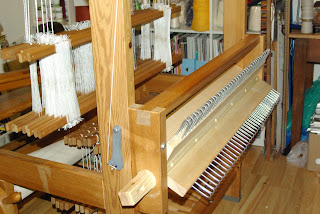Friday was spent weaving off the last of the dishcloth warp, and then in the afternoon I set myself to beaming on a warp using the sectional beam and the tension box, for the first time. As luck would have it, my next project was a baby blanket I've been commissioned to make by a friend whose sister is due to deliver a little boy in February. The cotton I ordered for it is quite chunky - 12 wpi, the most coarse yarn I've ever woven with.
The first challenge was to get the yarn into a form that I could wind off. I've taken the challenge of beaming sectionally without a spool rack, directly from cones. First the yarn had to be split onto the right number of cones cones. I needed 8epi therefore 8 cones for each section, and I had ordered four cones of each of the two colours for the blanket. Using the cone winder attachment I've developed after seeing Curiousweaver's approach and the yarn counter on the tension box, I wound the correct amount of yarn onto cones. In this case, for each of 17 sections, I needed 4 metres of yarn = 68 metres on each cone. Add 5% for differing tensions. Knowing from experimentation that 8 rotations on the yarn counter on the Glimakra tension box equals a metre, I wound on 560 counts or yarn onto four cones. They weren't pretty because of a few teething errors with the cone winding attachment, but they worked.
I have found that a problem with doing papier-mache with PVA glue in winter is that it takes forever to dry. I made the attachment weeks and weeks ago and the centre is still mushy and a bit glue-like. In addition to that, the PVA has done a poor job of sticking to the plastic sticky tape around the central quill. To fix that, I'm going to try a judicious application of a different glue - something faster-curing and harder, like super glue.
The next step was to rig up something that would allow the yarn to come directly up from the cones. I'm lucky in that I have a large bookcase behind where I sit on the loom bench. I achieved an in-situ cone rack for the grand sum of 88p, with a piece of scrap decking timber, a few small eyelet hooks, and a couple of books to weight the wood down and balance it from the front of the bookcase.

No problems there whatsoever. The cones unwound as they should, none of the yarns tangled, and all went smoothly. I'd call this approach a success and a keeper. I can add more pieces of wood and eyelets along the bookcase as required for finer threads.
Running the yarns through the centre of the loom, I threaded the tension box. I put yarns through the first reed widely spaced to keep them seperate, over under and over the round dowel tension rods, and into the second reed, at 10 epi. I beamed at 10epi despite wanting a set of 8 epi, because 10 epi gave me an even spread in the sections.

I spent ages trying to figure out how to space the threads. The draft for this project was a 5-end huck lace, giving blocks 2 inches wide, with 15 threads per block. It's easy enough to sley because the yarn wanted to sley at 8epi anyway, so each block would be slightly less than 2 inches. But how to divide 15 thread between two sections when beaming? I mulled over this in the back of my head for days before I realised that I didn't have to beam at 8 ends per section in every section. I could alternate sections of 8 ends with sections of 7 ends, to give 15 ends per block. So this is what I did, beaming all of the 8eps blue sections, then all the 7 eps blue sections, and repeating for the yellow. My only defense here is that the long days I've been working lately involve making sure that lots of numbers are in the right place and fitting a pattern, and I clearly need to turn that part of my brain off when I get home!
As each section was wound on to the right length, I'd cut the warp yarns and tape them flat into place. When the time came to thread the heddles, I hung a pair of lease sticks from the castle (one would have been enough but they were tied together), wound the warp beam on a little and then, one by one, untaped the yarn packages from the warp beam, pulled them forward and taped them onto the lease sticks, so that they were reachable from the front of the loom. I didn't make a cross as the tape kept the ends in order. In the photo below, you can see some packets of yarn threaded on the right, and the next packets still taped to the lease sticks on the left. You can also see a dining chair in the background of this photo. To thread the heddles, I remove the beater and breast beam, and sit on a low chair in the loom.

And from the front of the loom, you can see how easy it is to select each end from the tape as threading continues:

Admittedly this is the coarsest yarn I've ever worked with, so threading and sleying were faster than they normally are, but I had the whole warp beamed, threaded, sleyed and laced on at the correct tension in a single evening - perhaps 4-5 hour's work. It used to take me a day and a half.
I'm so pleased I bought the sectional warp beam!
As a final photo, a half-hearted attempt at snow at my house on Sunday. Nothing like Cally's!










